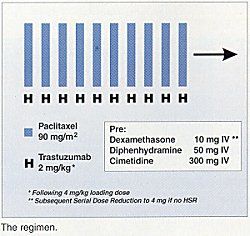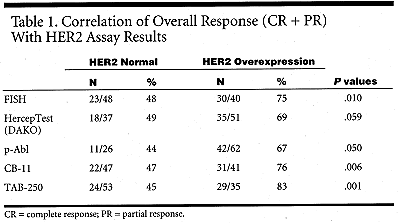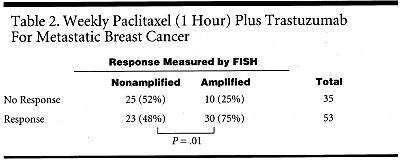Weekly Taxol/Herceptin: 60% RR in Metastatic Breast Cancer
NEW YORK-A new regimen of weekly paclitaxel (Taxol) plus the monoclonal antibody trastuzumab (Herceptin) produced an overall response rate of 60% among metastatic breast cancer patients, regardless of HER2 status, according to a study presented at the ASCO meeting.
NEW YORKA new regimen of weekly paclitaxel (Taxol) plus the monoclonal antibody trastuzumab (Herceptin) produced an overall response rate of 60% among metastatic breast cancer patients, regardless of HER2 status, according to a study presented at the ASCO meeting.
In conventional dosing, trastuzumab has been given weekly and paclitaxel every 3 weeks. Giving a lower dose of paclitaxel more often is based on the concept of dose density, lead investigator Andrew Seidman, MD, of Memorial Sloan-Kettering, said in an interview. Allowing less time between may offer less opportunity for drug-resistant cells to grow.
He noted further that the weekly regimen has already demonstrated significant antitumor activity and remarkable tolerability and safety.

The study involved 95 patients with a mean age of 51 years. They were given weekly paclitaxel at 90 mg/m² (1-hour infusion) and weekly trastuzumab (4-mg/kg loading dose in a 90-minute IV infusion and then 2 mg/kg in a 30-minute IV infusion) (see Figure).
The median number of prior regimens was 1, with 59% having had prior adjuvant therapy, 66% prior anthracycline treatment, and 13% prior paclitaxel therapy at least 1 year previously.
Predictor of Response
Investigators measured HER2 overexpression through a variety of assays (DAKO, p-Abl, CB-11, TAB-250, FISH).
The overall response rate among 88 evaluable patients, Dr. Seidman reported, was 60.2% (three complete responses), regardless of HER2 status, with a median response duration of 6 months. The range of responses among HER2-positive patients across the various assays was 67% to 83% (see Table 1).

FISH was a very good predictor of response, Dr. Seidman said. Those who showed gene amplification had a 75% chance of response and those without, a 48% chancea significant difference (see Table 2).

Dr. Seidman added that immunohistochemistry testing of specimens stored for prolonged periods can lead to false negatives, while polyclonal antibody tests, such as DAKO, can produce false positives. The simple message is that monoclonal antibodies and FISH seem to be more optimal predictors of therapeutic response, Dr. Seidman said.
The major dose-limiting toxicity was neuropathy (10% grade 3, 1% grade 4). Neutropenia occurred in 14%, with three episodes of febrile neutropenia.
Because of prior concerns about potential cardiac toxicity, investigators carefully monitored patients for left ventricular hypertrophy and found evidence of congestive heart failure in two patients and myocardial infarction in two more, for a major cardiac event rate of 6%.
Our data afford some measure of comfort that this combined use of paclitaxel and trastuzumab is safe for the myocardium of the vast majority of patients, Dr. Seidman stated.
He concluded that the regimen of weekly paclitaxel and trastuzumab had significant activity in patients who overexpressed HER2 and in those who did not. This trial cannot definitively answer whether trastuzumab is likely to contribute anything to the nonoverexpressersbut we have integrated trastuzumab dosing to a portion of that group in CALGB [Cancer and Leukemia Group B] 9840, a trial of weekly paclitaxel vs paclitaxel every 3 weeks, Dr. Seidman stated.
Newsletter
Stay up to date on recent advances in the multidisciplinary approach to cancer.